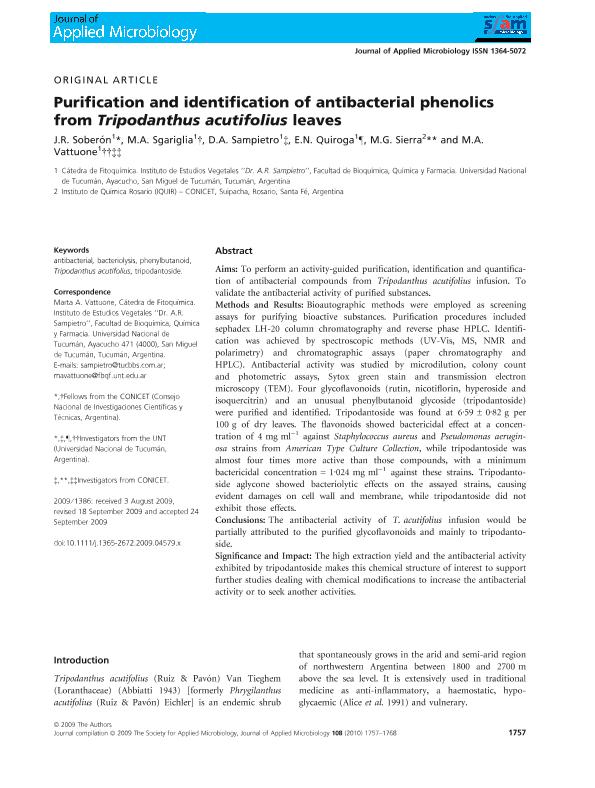Artículo
Purification and identification of antibacterial phenolics from Tripodanthus acutifolius leaves
Soberon, Jose Rodolfo ; Sgariglia, Melina Araceli
; Sgariglia, Melina Araceli ; Sampietro, Diego Alejandro
; Sampietro, Diego Alejandro ; Quiroga, Emma Nelly; Sierra, M. G.; Vattuone, Marta Amelia
; Quiroga, Emma Nelly; Sierra, M. G.; Vattuone, Marta Amelia
 ; Sgariglia, Melina Araceli
; Sgariglia, Melina Araceli ; Sampietro, Diego Alejandro
; Sampietro, Diego Alejandro ; Quiroga, Emma Nelly; Sierra, M. G.; Vattuone, Marta Amelia
; Quiroga, Emma Nelly; Sierra, M. G.; Vattuone, Marta Amelia
Fecha de publicación:
09/2009
Editorial:
Wiley Blackwell Publishing, Inc
Revista:
Journal of Applied Microbiology
ISSN:
1364-5072
Idioma:
Inglés
Tipo de recurso:
Artículo publicado
Clasificación temática:
Resumen
Aims: To perform an activity‐guided purification, identification and quantification of antibacterial compounds from Tripodanthus acutifolius infusion. To validate the antibacterial activity of purified substances.
Methods and Results: Bioautographic methods were employed as screening assays for purifying bioactive substances. Purification procedures included sephadex LH‐20 column chromatography and reverse phase HPLC. Identification was achieved by spectroscopic methods (UV‐Vis, MS, NMR and polarimetry) and chromatographic assays (paper chromatography and HPLC). Antibacterial activity was studied by microdilution, colony count and photometric assays, Sytox green stain and transmission electron microscopy (TEM). Four glycoflavonoids (rutin, nicotiflorin, hyperoside and isoquercitrin) and an unusual phenylbutanoid glycoside (tripodantoside) were purified and identified. Tripodantoside was found at 6·59 ± 0·82 g per 100 g of dry leaves. The flavonoids showed bactericidal effect at a concentration of 4 mg ml−1 against Staphylococcus aureus and Pseudomonas aeruginosa strains from American Type Culture Collection, while tripodantoside was almost four times more active than those compounds, with a minimum bactericidal concentration = 1·024 mg ml−1 against these strains. Tripodantoside aglycone showed bacteriolytic effects on the assayed strains, causing evident damages on cell wall and membrane, while tripodantoside did not exhibit those effects.
Conclusions: The antibacterial activity of T. acutifolius infusion would be partially attributed to the purified glycoflavonoids and mainly to tripodantoside.
Significance and Impact: The high extraction yield and the antibacterial activity exhibited by tripodantoside makes this chemical structure of interest to support further studies dealing with chemical modifications to increase the antibacterial activity or to seek another activities.
Archivos asociados
Licencia
Identificadores
Colecciones
Articulos(CCT - NOA SUR)
Articulos de CTRO.CIENTIFICO TECNOL.CONICET - NOA SUR
Articulos de CTRO.CIENTIFICO TECNOL.CONICET - NOA SUR
Articulos(INSIBIO)
Articulos de INST.SUP.DE INVEST.BIOLOGICAS
Articulos de INST.SUP.DE INVEST.BIOLOGICAS
Articulos(PROIMI)
Articulos de PLANTA PILOTO DE PROC.IND.MICROBIOLOGICOS (I)
Articulos de PLANTA PILOTO DE PROC.IND.MICROBIOLOGICOS (I)
Citación
Soberon, Jose Rodolfo; Sgariglia, Melina Araceli; Sampietro, Diego Alejandro; Quiroga, Emma Nelly; Sierra, M. G.; et al.; Purification and identification of antibacterial phenolics from Tripodanthus acutifolius leaves; Wiley Blackwell Publishing, Inc; Journal of Applied Microbiology; 108; 5; 9-2009; 1757-1768
Compartir
Altmétricas



